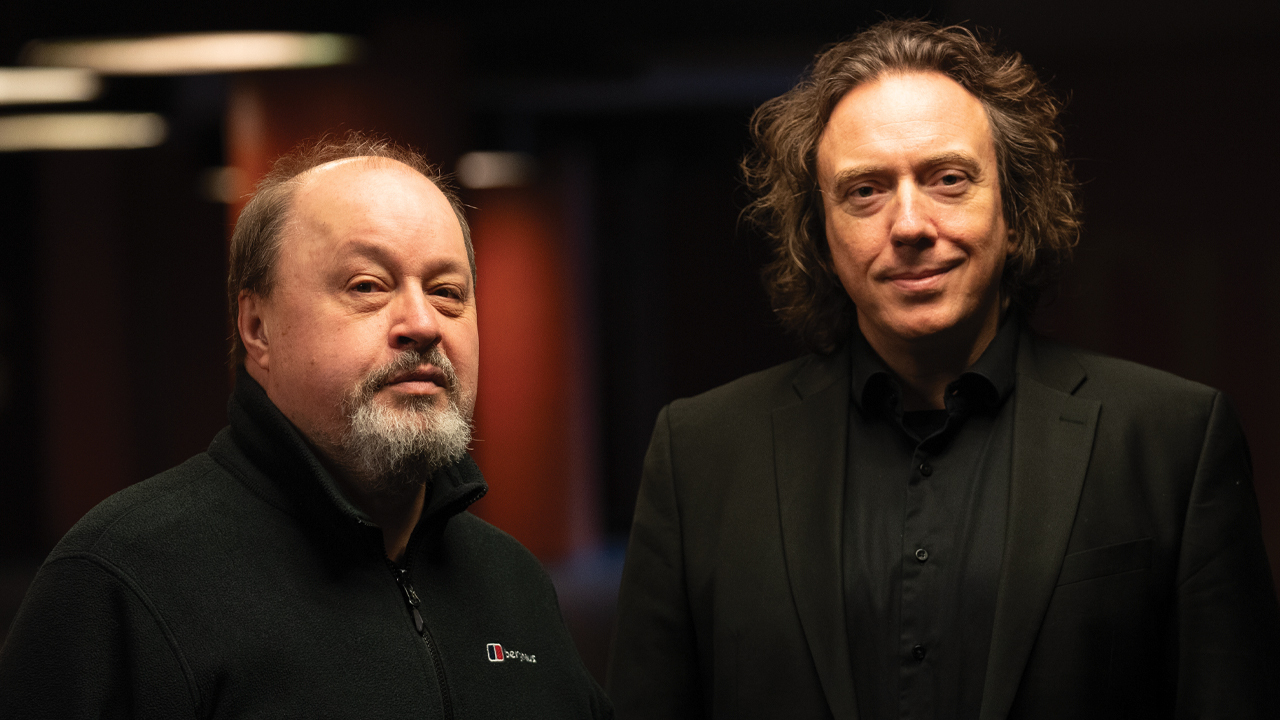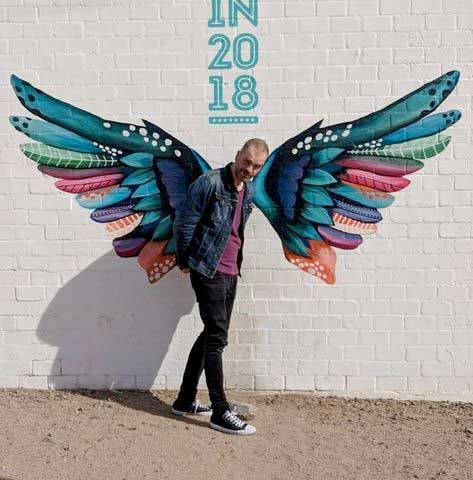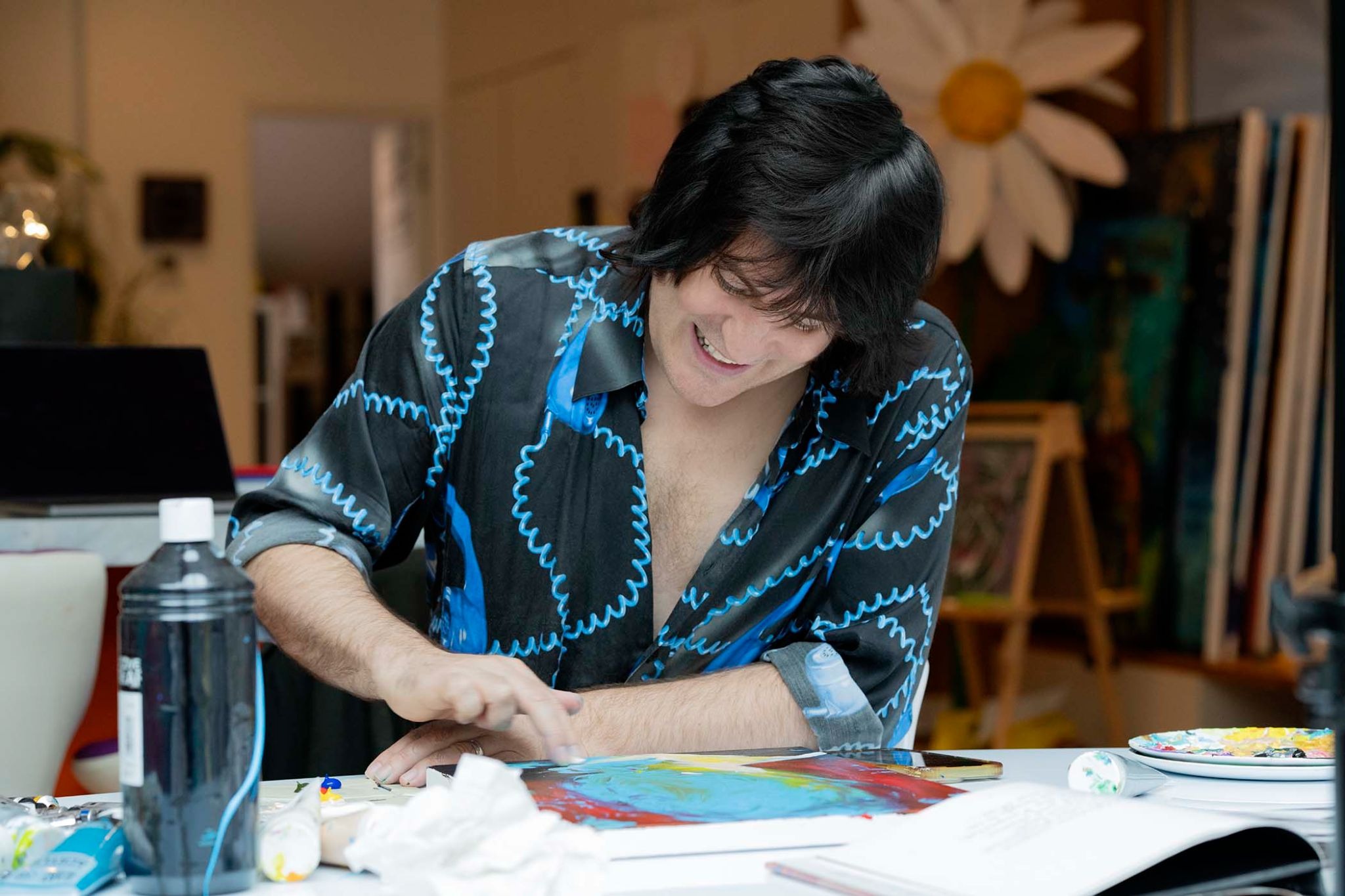“There was one troll who slagged it off, but I think he was a fan from the Fish years!” Marillion’s Steve Rothery and Tangerine Dream’s Thorsten Quaeschning took six years to make Gentō, an album that sounds like neither of their bands
Their Bioscope debut arrived after the pair took advice from Steven Wilson, spent a week every winter exploring sounds and ideas, and borrowed Elbow’s drummer to fulfil their instrumental cinematic vision

Bioscope began as a vague idea for two musicians from very different parts of the prog world to jam together. It turned into an exciting electro-instrumental project, brought to fruition with debut album Gentō. Marillion’s Steve Rothery and Tangerine Dream’s Thorsten Quaeschning tell Prog about the long-gestating release.
Somewhere in Steve Rothery’s archive is a piece of electronic music that’s only ever been heard in public once, almost 40 years ago. It consists of sequenced keyboards with a dusting of guitar – a far cry from the sounds he’s best-known for as guitarist with Marillion.
“I came up with it when we were writing Clutching At Straws,” Rothery says, referring to his band’s 1987 album. “When Fish was leaving, I was asked to do a music show in the Netherlands, and I used that piece of music as a backing track to play over. That’s the one time I played it; no one’s ever heard it since.”
All these years later, Rothery has grabbed his chance to scratch his electronic music itch. He’s teamed up with Thorsten Quaeschning, latterday leader of Tangerine Dream, to form Bioscope. The pair’s instrumental debut album, Gentō, is a cinematic fusion of Quaeschning’s shapeshifting keyboards and Rothery’s fluid playing. Their respective musical DNA is inevitably fused deep into the music – but it doesn’t sound like Marillion or Tangerine Dream.
Bioscope wasn’t the first choice of name; the guitarist admits it was nearly called The Rothery Quaeschning Project. “Until somebody – I think it was Steven Wilson – said that sounded like a firm of accountants! Once I got past being offended, I agreed with him.”
There’s a clear mutual admiration between the two, and both are well-versed in the other’s work. “I’ve always been aware of Tangerine Dream,” says Rothery. “When I was 15 or 16, growing up in Whitby, I listened to the Ricochet and Stratosfear albums. It was so different to all the classic prog bands I was getting into. Compared to Genesis or Yes, Tangerine Dream felt like they were from a different planet. The pulsing sequence of their music was a whole different musical vocabulary.”
Quaeschning was similarly enamoured of Marillion in his youth. The keyboardist – who joined Tangerine Dream in 2005 and became their musical director two years before founder Edgar Froese’s death in 2015 – was raised on the prog greats. But in the early 1990s a friend gave him a bundle of CDs including Misplaced Childhood, Clutching At Straws, Seasons End and Holidays In Eden.
Sign up below to get the latest from Prog, plus exclusive special offers, direct to your inbox!
“It wasn’t clichéd hard rock with all these power chords,” he says. “I went out and bought Brave and I loved it. I’ve seen them on every tour since then, and they’ve been some of my favourite concerts.”
They first met in person when Marillion and Tangerine Dream took part in 2014’s Cruise To The Edge. But it wasn’t until a Marillion show in Berlin in December 2018 that the seeds of Bioscope were planted. At that stage it was little more than a suggestion that they jam together; and Rothery flew back to the German capital the following February for a couple of days. He recalls: “It was a cool concept – ‘This could be good, both our worlds colliding. Some interesting work could come from this.’”
Rothery returned to Berlin once a year, usually in December, when he and Quaeschning would hole up for five days in the latter’s studio. It seems like a piecemeal way of doing things, but the lack of external and internal pressure suited them both, as did the absence of expectation. “We just wanted to see how it worked and in what direction it could be taken,” says Quaeschning. “There was no plan to make it very proggy or very ambient-esque. We just decided to play and see what happens.”
Rothery adds: “The only way I can describe it is like a dialogue. We both had complete creative freedom to do what we wanted to do. There was a really organic development of a lot of ideas. When you’re working in a band, you’re working in a democracy – you can’t have five people steering the ship, so sometimes things evolve at a very slow rate. To have something very spontaneous and in-the-moment is really refreshing.”
They found their partnership a novel experience. “Thorsten’s approach, his musical themes and his textures are very different to how Mark Kelly works, but it’s inspiring,” says Rothery. “It felt natural to me. I just do what I do on top of it, as opposed to a more straightforward rock thing.”
Quaeschning was likewise energised by Rothery’s presence – though he admits to being slightly baffled by the guitarist’s more meditative approach. “Steve only starts playing if he finds the right sound,” he says. “On one session I was playing and playing, keeping the sequencer rolling, and Steve was just playing one note. It went on for half an hour. I thought, ‘He must hate what I’m playing!’ But he was just searching for the right sound.”
The guitarist laughs at the question of whether working together was difficult “I think the most difficult thing was deciding what we were going to have for dinner that night!” he says. “No, from my point of view it was quite effortless.”
Effortless, certainly, but also long. Open-ended jams are fine, but without a deadline they felt no urgency to wrap things up. In 2024 they finally decided they had something approaching an album. That’s when they enlisted the help of Elbow drummer Alex Reeves.
You have to transport people without telling them what to feel. To find a shared trigger is the goal
Thorsteen Quaeschning
“I’d listened to loads of YouTube clips and nobody seemed quite right,” says Rothery. “A friend of mine recommended Alex, because he’s done a few sessions for other people. So I messaged him and sent him some musical ideas, and he did backflips about it!”
When Reeves completed his drum parts in two days, Bioscope was transformed into something solid – and it had only taken six years. But while Gentō’s gestation period may have been long, it doesn’t sound remotely tortuous. It consists of three longer, multipart pieces (Vanishing Point, Kinetoscope and Bioscope) plus two shorter pieces (Gentō itself and Kaleidoscope). It really does feel like two worlds coming together. “It’s definitely a combination of the different aspects of our personalities and backgrounds,” says Quaeschning.
The cinematic quality of the music is no coincidence – the abstract concept of visual arts runs through the album. Bioscope take their name from an early type of projector, while the album takes its title from a 17th-century Japanese magic lantern which created a primitive moving image. All the track titles have their roots in film or photography.
“Cinema and photography has always been a huge passion of mine,” says Rothery, who published photography book Postcards From The Road in 2016. “I came across the bioscope – one of the original motion-picture formats, developed in Berlin by two brothers in the 1800s – and the idea seemed to suit what we were doing. Even though we didn’t have that in mind when we started, once you’ve named something, it helps define it in your head.”
He draws parallels with 2014 solo album The Ghosts Of Pripyat. “It’s like you’re trying to create soundtracks for imaginary movies,” he says. “And of course, Tangerine Dream have a long pedigree of film soundtrack work, from things like Risky Business to the work Thorsten does in film and video games. There’s almost a visual dimension to what we’re doing.”
Some of what I’ve learned have definitely fed into what I’ve been doing with Marillion
Steve Rothery
For Quaeschning it’s about triggering emotions with instrumental music.“You have no words so you have to transport people without telling them what to feel,” he says. “To find a shared trigger is the goal, and I think we found that.”
Gentō certainly moves the emotions; but there’s the question of how it will be received by the duo’s respective fanbases. Marillion followers can have a very clear and sometimes loudly-expressed idea of what the band should sound like. But Rothery says the response has been almost overwhelmingly positive. “There was one troll who slagged it off, but I think he was a fan from the Fish years!” says the guitarist wryly.
Quaeschning says fans of his own band are generally open-minded, and the fact that Rothery joined Tangerine Dream for a handful of shows in 2023 brought him into the family. “That was kind of the holy blessing,” he says.
Shows beyond those scheduled in December depend on the on the duo’s day jobs. While Tangerine Dream’s plans are slightly vague beyond touring, Marillion are currently working on a new album – “Some of the things I’ve learned from working with Thorsten have definitely fed into what I’ve been doing,” says Rothery.
A second Bioscope album is not beyond the realms of possibility. “Absolutely,” says Quaeschning. “I really enjoyed the process of making this one.”
“I’d like to think so,” agrees Rothery. “We didn’t know how this would turn out, but it’s turned out brilliantly. It lets us explore different avenues with each other, which is why we do this.”
Dave Everley has been writing about and occasionally humming along to music since the early 90s. During that time, he has been Deputy Editor on Kerrang! and Classic Rock, Associate Editor on Q magazine and staff writer/tea boy on Raw, not necessarily in that order. He has written for Metal Hammer, Louder, Prog, the Observer, Select, Mojo, the Evening Standard and the totally legendary Ultrakill. He is still waiting for Billy Gibbons to send him a bottle of hot sauce he was promised several years ago.
You must confirm your public display name before commenting
Please logout and then login again, you will then be prompted to enter your display name.





